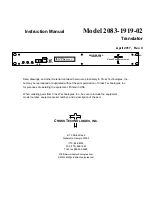
Appendices
980
Chord SW
This enables and disables Chord mode. For more
information, see “Using Chord mode” on page 49 of
the Operation Guide.
Realtime Knobs 5–8 Assignments
Knob assignments are saved separately with each
Program, Combination, and Song. In Sampling mode,
assignments apply to the entire mode. For more
information, see:
• HD-1 Programs: “1–8: Set Up Controllers” on
• EX
i
Programs: “4–8: Set Up Controllers” on
• Combinations: “1–8: Set Up Controllers” on
• Sequencer mode: “1–8: Set Up Controllers” on
• Sampling mode: “4–8: Set Up Controllers” on
Knobs and MIDI CCs
Some of the assignments include MIDI CCs, which are
transmitted whenever the knob is moved. Note that
the MIDI CCs can still be received even if they are not
assigned to a physical controller.
List of Knob 5-8 assignments
The following functions can be assigned to REALTIME
KNOBS 5–8.
Off
This setting disables the knob.
Knob Mod. 5–8 (CC#s17, 19, 20, 21)
These settings let you use the knob as an AMS or
Dmod source. Note that you’ll also need to assign the
knob to control the desired parameter within the
Program or Effect.
Master Volume
This controls the overall volume, and transmits the
Universal System Exclusive Master Volume message
[F0H, 7FH, nn, 04, 01, vv, mm, F7H]. You can use this to
adjust the volumes of all Tracks or Timbres at the same
time, while preserving their relative balance.
For more information, see the diagram under “Master
Volume Slider” on page 21.
Portamento Time (CC#05)
This controls the portamento time. Note that a
different controller, CC#65, turns Portamento on and
off; see “Portamento SW (CC#65)” on page 979.
Volume (CC#07)
Controls the volume, and transmits CC#7.
Post IFX Pan (CC#08)
Controls the panning after the last Insert Effect in the
chain, and transmits CC#8.
Pan (CC#10)
Controls stereo pan, and transmits CC#10.
Expression (CC#11)
Expression is a secondary volume control, which you
can use to scale level without affecting the main
volume settings or CC#7 values.
When used one at a time, MIDI Volume and
Expression affect level in exactly the same way: a MIDI
value of 127 is equal to Program’s main Level setting,
and lower values reduce the volume.
If both CC#7 and CC#11 are used simultaneously, the
one with the
lower
value determines the maximum
volume, and the one with the
higher
value scales down
from that maximum.
FX Control 1 & 2 (CC#s12 & 13)
These assignments are intended for Effect Dynamic
Modulation (Dmod). Note that you’ll also need to
assign
FX Control 1
or
2
to control the desired
parameter within the Effect.
LFP Cutoff (CC#74)
This scales the cutoff frequency of all of the filters at
once. For instance, in the HD-1, it affects both Filters A
and B.
Resonance (CC#71)
This scales the resonance of all of the filters at once. For
instance, in the HD-1, it affects both Filters A and B.
Filter EG Int. (CC#79)
This scales the effect of the Filter EG on the cutoff
frequency. It affects all of the filters at once; for
instance, in the HD-1, it affects both Filters A and B.
F/A Attack (CC#73)
This scales the attack times of the Filter and Amp EGs,
along with other related parameters.
When the CC value is above 64, this also affects the
Amp EG’s Start and Attack Levels, Start Level AMS,
and Attack Time AMS, as described below:
Between values of 65 and 80, the Start Level, Start
Level AMS, and Attack Time AMS will change from
their programmed values to 0. Over the same range,
the Attack Level will change from its programmed
value to 99.
F/A Decay (CC#75)
This scales the decay and slope times of the Filter and
Amp EGs.
F/A Sustain (CC#70)
This scales the sustain levels of the Filter and Amp
EGs.
Summary of Contents for Electronic Keyboard
Page 1: ...Parameter Guide Parameter Guide ...
Page 2: ......
Page 180: ...Program mode EXi 170 ...
Page 290: ...EXi STR 1 Plucked String 280 ...
Page 572: ...Sequencer mode 562 ...
Page 700: ...Global mode 690 ...
Page 751: ...Insert Effects IFX1 IFX12 Routing 741 Fig 2 3a Fig 2 3b ...
Page 902: ...Effect Guide 892 ...
















































